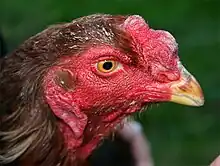_from_Alanganallur%252C_Madurai_(cropped).jpg.webp) | |
| Conservation status | |
|---|---|
| Other names | Aseel |
| Country of origin | India |
| Distribution | international |
| Use | |
| Traits | |
| Weight | |
| Egg colour | tinted, cream to brown[4]: 9 |
| Classification | |
| APA | all other standard breeds[5]: 16 |
| EE | yes[6] |
| PCGB | Asian hard feather[7] |
| |
The Asil or Aseel is an Indian breed or group of breeds of game chicken. It is distributed in much of India, particularly in the states of Tamil Nadu, Andhra Pradesh, Chhattisgarh and Odisha;[2] it has been exported to several other countries. Similar fowl are found throughout much of Southeast Asia.
It is one of the parent breeds of the Indian Game, developed in the West Country of England in the early nineteenth century.[8]
History
The Asil originated in the Indian subcontinent, the area that includes modern India, Pakistan, Bangladesh and Sri Lanka;[9] it is thought to be among the oldest breeds of fighting cock.[10]: 47 [11] The word "Asil" is from Arabic, and means "purebred".[9] In India, it is a general term for all fighting breeds.[4]
In India the Asil is distributed particularly in the Khammam district of Andhra Pradesh, in the Bastar and Dantiwara districts of Chhattisgarh, and in the Koraput and Malkanagiri districts of Odisha.[2] It is also present in Bangladesh and Pakistan, which were part of India until Partition, and is found in other countries including Australia, Guatemala, Honduras, Ireland, Luxembourg, the United Kingdom, the United States and Uruguay.[12]
An Asil bantam was created in the late nineteenth century by the British breeder William Flamank Entwisle;[13]: 47 it became popular in Britain and in Holland, but later died out.[9] In the 1980s it was re-created in Belgium by Willy Coppens, using Shamo, Indian Game and Reza Asil; it is bred in Austria, Belgium, Germany, Holland, Hungary and the United Kingdom, in a variety of colours.[9]
In 2005 the Asil was the only Indian breed of chicken not in need of conservation.[14]: 17 In 2007 its global conservation status was listed by the FAO as "not at risk".[1]: 151 In 2021 its status was reported to DAD-IS as "unknown";[2] the Livestock Conservancy in the United States listed it as "threatened".[15]
Characteristics



There are many varieties of Asil. Among them are the Amroha, Bhaingam, Kilimooku, Kulang, Lasani, Madras, Mianwali, Reza and Sindhi types.
Use
Asil hens are not good layers, but sit well. They may lay about 70 eggs per year; the eggs vary from cream-coloured to brownish, and weigh approximately 40 g.[2]
Asil chicken in Pakistan
In Pakistan, cockfighting is a well-liked sport, but the Prevention of Gambling Act of 1977 makes betting on it unlawful. However, police frequently ignore it. People in Sindh prefer to keep the trained breed known as Sindhi Aseel for this purpose, while Mianwali Aseel is another well-liked breed that has been trained for combat.
Sindh, the top supplier of fighter Asil birds and the primary location for cockfights, considers it illegal to arm the birds with either metal spurs (referred to as gaffs) or knives. Some competitions permit it in Hower Punjab, which ranks third in cockfighting after KPK
References
- 1 2 Barbara Rischkowsky, Dafydd Pilling (editors) (2007). List of breeds documented in the Global Databank for Animal Genetic Resources, annex to The State of the World's Animal Genetic Resources for Food and Agriculture. Rome: Commission on Genetic Resources for Food and Agriculture, Food and Agriculture Organization of the United Nations. ISBN 9789251057629. Archived 23 June 2020.
- 1 2 3 4 5 6 7 Breed data sheet: Aseel / India (Chicken). Domestic Animal Diversity Information System of the Food and Agriculture Organization of the United Nations. Accessed August 2021.
- 1 2 3 4 J. Ian H. Allonby, Philippe B. Wilson (editors) (2018). British Poultry Standards: complete specifications and judging points of all standardized breeds and varieties of poultry as compiled by the specialist breed clubs and recognised by the Poultry Club of Great Britain, seventh edition. Chichester; Hoboken, New Jersey: Wiley Blackwell. ISBN 9781119509141.
- 1 2 Rassetafeln: Hühner (in German). Reichenbach, Haselbachtal: Bund Deutscher Rassegeflügelzüchter. Accessed August 2021.
- ↑ APA Recognized Breeds and Varieties: As of January 1, 2012. American Poultry Association. Archived 4 November 2017.
- ↑ Liste des races et variétés homologuée dans les pays EE (28.04.2013). Entente Européenne d’Aviculture et de Cuniculture. Archived 16 June 2013.
- ↑ Breed Classification. Poultry Club of Great Britain. Archived 12 June 2018.
- ↑ Indian Game. Poultry Club of Great Britain. Accessed August 2021.
- 1 2 3 4 Willem van Ballekom (August 2006). Asian Gamefowl Breeds: The Aseel. Aviculture Europe. 2 (4), article 5. Accessed August 2021.
- ↑ Victoria Roberts (2008). British Poultry Standards: complete specifications and judging points of all standardized breeds and varieties of poultry as compiled by the specialist breed clubs and recognised by the Poultry Club of Great Britain, sixth edition. Oxford: Blackwell. ISBN 9781405156424.
- ↑ Chickens: Asian Hard Feather. Poultry Club of Great Britain. Archived 23 November 2018.
- ↑ Transboundary breed: Aseel. Domestic Animal Diversity Information System of the Food and Agriculture Organization of the United Nations. Accessed April 2022.
- ↑ William Flamank Entwisle (1894). Bantams. Wakefield: Edith H. Entwisle.
- ↑ [Department of Animal Husbandry & Dairying] (2005). Country Report on Animal Genetic Resources of India, archived 22 August 2021. Annex to: Barbara Rischkowsky, Dafydd Pilling (editors) (2007). The State of the World's Animal Genetic Resources for Food and Agriculture. Rome: Commission on Genetic Resources for Food and Agriculture, Food and Agriculture Organization of the United Nations. ISBN 9789251057629. Archived 10 January 2017.
- ↑ 2021 Conservation Priority Poultry Breeds. The Livestock Conservancy. Archived 22 August 2021.
Further reading
- Esther J.J. Verhoef-Verhallen, Aad Rijs (2003). The complete encyclopedia of chickens. Lisse: Rebo International, ISBN 9789036615921